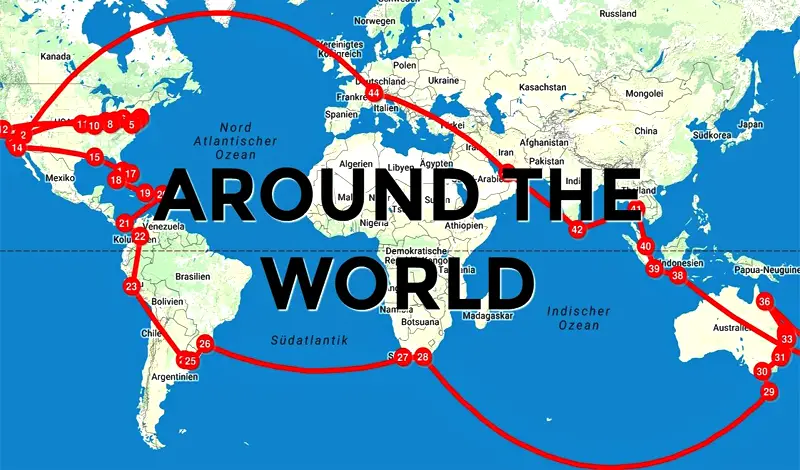How long would it take to travel the world? It depends on the mode of transport, right?
It’s physically impossible for any modern aircraft to fly around Earth in less than 24 hours.

Before we get started, it must be said that this article is purely speculative. While some of the calculations are backed up by theoretical physics (read: the math makes sense), none of it has been done.
How long would it take to travel the world?
To be precise, how long would it take to circumnavigate the world if you traveled in a straight line?
How about… 30 minutes?
That’s right. It’ll take 30 minutes of flying time to get around the entire planet. Here’s how I worked that out.
THEORETICAL PHYSICS – NOT REAL LIFE
For the sake of this article, I’m going to assume a few things.
1. If you travel in a straight line, it doesn’t matter where on Earth you start from. You will always arrive back at your starting point after 30 minutes.
2. You can accelerate indefinitely without any physical limitation.
3. The Earth is perfectly spherical, with a radius of 6,371 km.
Now that we know what assumptions I’m working under let’s get started.
I will try to be as accurate as possible in this article, but please remember that I am not an expert in theoretical physics.
So, how long will it take to travel the world?
It would take you 30 minutes to travel around the world if you traveled in a perfectly straight line.
Your speed will increase as you begin to move, and it will continue to grow at a constant rate. We must know how fast this acceleration is, so let’s calculate that before we get into anything else.
The equation for instantaneous acceleration is
a = ∆d/∆t
Where a equals acceleration, ∆d is the change in distance, and ∆t is the change in time. We know that it will take us half an hour to circumnavigate the Earth, which means it will have taken us one hour to travel around our planet.
This means that ∆d = R, where R is the radius of Earth (6,371 km). We also know that ∆t = 1 hour, so we can substitute this into our equation for acceleration.
a = 6,371km/1h
That’s a change in velocity every 36 minutes or 0.15 km/h
in theory; if we constantly accelerate at this rate, we’ll get to the speed of light.
In reality, though, there are a few additional factors that would stop us from accelerating indefinitely. The main one is G-force or gravitational force. Our bodies just aren’t equipped to handle speeds of that magnitude, and you would blackout.
But wait, there’s more!
Let’s say we don’t accelerate at a constant rate and instead travel for half an hour until our speed is incredibly fast. We’ll call this our cruising speed.
Our acceleration equation would then look like this:
a = ∆v/∆t
Where ∆v is the change in velocity, we already know that our cruising speed will be 3,282km/h (2,000 mph).
So let’s plug that into our equation for acceleration:
a = 6,371km/30m
a = 0.2 km/h²
That’s a pretty small number considering the power of modern fighter jets.
So, to recap: it would take you 30 minutes to circumnavigate the entire planet if you traveled in a straight line at an acceleration of 0.2 km/h².
Long way down
Now that we know how long it will take us to travel worldwide, let’s turn our attention to what it would be like to travel down.
If you dropped from space, you’d fall towards the Earth’s center at a speed of 9,842 km/h (6,100 mph).
Traveling that fast is incredibly dangerous, and even a slight mistake could have disastrous consequences. You would reach terminal velocity after only 1 minute and 15 seconds.
Terminal velocity is the maximum speed an object will travel when it falls towards the Earth’s center because of gravity.
This speed changes depending on a variety of factors, including weight, density, and surface area.
How long would it take to travel all around the world by train?
Let’s assume that we’re traveling on a train, which can achieve speeds close to that of or exceeding our cruising speed.
We know from our previous calculations that it will take us 30 minutes to circumnavigate the planet, and we’ll be traveling at an average velocity of 4,000 km/h (2,500 mph).
That’s 1 hour to travel around the world.
If we consider that it takes approximately 15 seconds for a train to stop, accelerate and make the necessary turns required to get off at our destination, it means that you need almost 100 hours or three days to travel all around the Earth.
So, I hope you’ve enjoyed this blog post and that you’re ready to travel back in time for your next train journey.
How long does it take to fly across the world?
As you may have guessed already, the time it takes to fly around the world is almost the same as if you were traveling by train.
This is because both air and rail travel at subsonic speeds, which means that they can only reach speeds close to or below the speed of sound (1,225 km/h or 761 mph).

So, we can calculate that it will take you two and a half hours to fly around the world.
Like with trains, one factor that affects how long it takes to get from one destination to another is how quickly an aircraft can stop and avoid crashing into other planes on the runway.
How long would it take to walk around the world?
It would take you two years, eight months, and 16 days to walk around the Earth. You’re probably wondering why it takes us so long to walk around the world.
The answer is that our speed would vary depending on how hilly or mountainous the terrain was.
We also need to factor in the time it takes to walk off your train or airplane and drink water and food.
So this is why our journey time has gone way over the planned two years that it would take to walk around the whole planet.
How long would it take you to travel around the world by car?
If you were driving on a completely straight road with no turns, no intersections, no traffic lights, and unlimited fuel, it would take you almost three days to travel around the planet.
This is because most roads are on a flat surface, making driving across our world very easy.
But of course, this doesn’t happen in real life, so we need to factor in more variables if we’re going to accurately calculate how long it would take to drive around the world.
When you’re driving, you need to stop refueling your car, which will add time to your journey. You’ll also need to replenish your car’s fluids because they can get boiling during extended periods of driving.
Let’s not forget that traffic lights exist in every country and on highways/motorways. You need to stop every time the road splits.
This is why our journey would last more than 30 hours or one day on average (just like with trains).
Just like before, your actual travel time will vary depending on your speeds. For example, if you’re driving at 100 km/h (60 mph), it would take you almost 24 days to travel around the world.
Advice
- This is possible in theory; it is not possible in practice, so think twice before traveling the whole world.
- Always keep an ample supply of water and food when you’re on the move.
- If you get stranded somewhere without food, always go for berries, seeds, and water from plants instead of hunting animals.
- Avoid drinking the water found in lakes, ponds, rivers, and other sources.
- Don’t sleep outside during the winter months; always sleep inside a building, so you don’t freeze to death.
You can also read it: How to travel to a different dimension: Top 10 best way
Conclusion
If you are one of the millions out there who has always dreamed about traveling around the world, it’s time to start planning your itinerary.
With so many unique places in this vast world, how long would it take to see them all? The answer may surprise you!
Read on for a map that will show you just how much ground you can cover before coming back home again.
If you have any questions, please leave a comment. I hope this article helped you understand how long it would take to travel the world, and if not, please contact me with questions or comments!
Have a nice trip!